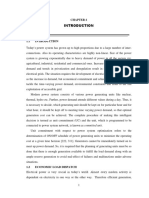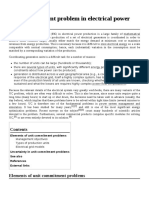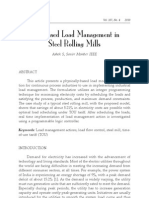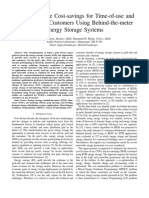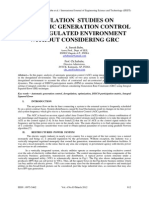A Case Study of Various Constraints Affecting Unit Commitment in Power System Planning
A Case Study of Various Constraints Affecting Unit Commitment in Power System Planning
Uploaded by
Alluri Appa RaoCopyright:
Available Formats
A Case Study of Various Constraints Affecting Unit Commitment in Power System Planning
A Case Study of Various Constraints Affecting Unit Commitment in Power System Planning
Uploaded by
Alluri Appa RaoOriginal Description:
Original Title
Copyright
Available Formats
Share this document
Did you find this document useful?
Is this content inappropriate?
Copyright:
Available Formats
A Case Study of Various Constraints Affecting Unit Commitment in Power System Planning
A Case Study of Various Constraints Affecting Unit Commitment in Power System Planning
Uploaded by
Alluri Appa RaoCopyright:
Available Formats
International Journal of All Research Education and Scientific Methods (IJARESM)
ISSN: 2455-6211, Volume 2, Issue 1, January 2014
A Case Study of Various Constraints Affecting
Unit Commitment in Power System Planning
Er. Amit Bhardwaj1, Prof. R. K. Sharma2, Er. Aashutosh Bhadoria3
1,2,3
Dept. of Electrical Engineering, Lovely Professional University, Jalandhar, Punjab, India.
ABSTRACT
In fact, the problem of Unit Commitment is a complicated decision making operation on account of various
operational constraints affecting the economical scheduling of units in an electrical power system. These
constraints could not be violated while determining the optimal or near optimal commitment schedule. This
paper presents a detailed study of various operational constraints which directly or indirectly have a great
impact on power system optimization problems. The knowledge of choosing various variables with the
appropriate operational constraints is absolutely a good deal in electrical power system planning and
optimization problems.
Keywords: Electrical Power System, Unit Commitment (UC), Operational Constraints.
INTRODUCTION
One of the most important problems in electrical power system planning and optimization is Unit Commitment. It
has a significant influence on secure and economic operation of power systems. The UC problems involve
scheduling the on/off states of generating units, which minimizes the operating cost, start-up cost and shut-down
cost for a given horizon under various operating constraints. It is the problem of determining which units and how
many should operate to meet a particular load level while satisfying specified operating criteria. To reach an
economic operation, some units should be considered for shutdown over a part or all of the scheduling time period.
In Power Systems, the investment is quite expensive, and the resources in running them are substantially becoming
sparse of which the focus turns to optimizing the running cost of the power systems. In todays world, it becomes an
extreme necessity to meet the demand as well as optimize the generation. In the UC problem, the decisions are the
selection of the time for each unit to be on and/ or offline (binary variables) as well as the units economic
generation level (continuous variables). Unit commitment problem is a non-linear, large scale, mixed integer
constrained optimization problem. The number of combinations of different variables grows exponentially for a
large-scaleunit commitment problem, which makes it difficult to solve in practice. Over the past decades, many
salient methods have been developed for solving the UC problems. The exact solution to the problem can be
obtained by complete enumeration, which cannot be applied to realistic power systems due to its computational
burdens. Adequate operating reserve is required in an electric power system to maintain a desired level of reliability
through a given period of time. The traditional unit commitment is one of difficult scheduling problems for
minimizing operation cost of units while satisfying the constraints on generators and system characteristics.
However, in recent years, power systems become deregulated and competitive so that the power system operation
requires the problem reformulation that reflects the changes under new environment.
The corresponding author gratefully acknowledges the guidance given by Prof. R. K. Sharma (HOD, Electrical
Engineering., Lovely Professional University, Punjab, India.). He also acknowledge the valuable suggestions
given by Er. Aashutosh Bhadoria (Asst. Prof., Electrical Engg. at Lovely Professional University, Phagwara,
India).
Corresponding Author: Amit Bhardwaj, Lovely Professional University, Jalandhar, India.
(amitbdwj47@gmail.com)
UNIT COMMITMENT PROBLEM FORMULATION
Page | 15
International Journal of All Research Education and Scientific Methods (IJARESM)
ISSN: 2455-6211, Volume 2, Issue 1, January 2014
The Power System Unit Commitment Problem can be stated as follows:
For an electrical utility with N generating units and given a certain price profile, it is required to determine the start
up/ shut down times and the power output levels of all the generating units at each time interval t over a specified
scheduling period T, so that the generators total profit is maximized , subject to the unit constraints.[1]
In the UCP under consideration, an interesting solution would be minimizing the total operating cost of the
generating units with several constraints being satisfied. The major component of the operating cost, for thermal
and nuclear units, is the power production cost of the committed units and this is given in a quadratic form in the
equation below[2] :
Fi(Pit) = Ai + Bi.Pit + Ci.Pit2
(i)
where,
Fi(Pit) is production cost of unit i at a time t (Rs/hr),
Ai, Bi and Ci are cost coefficients of unit i (Rs/MWh, Rs/h)
Pit is its output during hour t (MW)
The start-up cost Sit of unit i depends on the number of successive hours, Toffi, prior to the start-up hour, t, during
which it had been shut down. If SOi is its cold start-up cost, Tdni is its minimum down time (to be defined later in
this section) and di and e are its start-up cost coefficients, then Sit is given by[5]:
Sit = SOi{1 di[exp(-Toffi /Tdni)]} + ei
(ii)
Start-up cost is incurred only at OFF-ON transitions. Hence, if binary variable vit has a 1 value only if unit i is
started at hour t, then the total operational cost FT of the system of N units over T hours is given by[8]:
TN
FT = [Fi(Pit)uit + Sit. Vit ]
t=1 i=1
(iii)
where uit has a 1 value if the unit i is ON in hour t, and a 0 value if it is OFF in hour t. It is to be noted that u it and vit
are not independent, since vit=1 iff ui,t-1= 0 and uit = 1.
For the minimization of FT, some major constraints that must be taken into account includes[4]:
The total power output must meet the load demand plus system losses.
There must be enough spinning reserve to cover any shortfall in generation.
Energy constraints must he met.
The generation of each unit must be within its minimum and maximum allowable power output range.
The minimum up- and down-times of thermal generation units must be considered.
Ramp rates limits for thermal generation units must not be violated.
Hence, unit commitment [7-9] is a nonlinear, non-convex, large scale, mixed integer problem to determine a start-up
and shut-down schedule of generating units at minimum operating cost. In this problem, the demand and reserve
requirements and the constraints of the generating units must be satisfied. It should be mentioned that solving this
problem can be computationally expensive in large power systems. An improved formulation for the unit
commitment problem is especially valuable for advanced and computationally demanding problems such as
stochastic formulations or transmission switching. Even though the UC model was developed in an era of
monopolistic producers, it remains important today, even after the deregulation of the power industry. Unit
commitment problem can easily be extended to generate production schedules in a competitive market environment.
CONSTRAINTS IN UNIT COMMITMENT
Many constraints can be placed on the unit commitment problem. The list presented here is by no means exhaustive.
Each individual power system, power pool, reliability council, and so forth, may impose different rules on the
scheduling of units, depending on the generation makeup, load-curve characteristics, and such[5-6].
Page | 16
International Journal of All Research Education and Scientific Methods (IJARESM)
ISSN: 2455-6211, Volume 2, Issue 1, January 2014
SPINNING RESERVE CONSTRAINTS
It can be defined in many ways according to:
Wood and Wollenberg [6]: the total synchronised capacity, minus the losses and the load;
British Electricity International [3]: the additional output which is part-loaded generating plant is able to
supply and sustain within 5 minutes. This category also includes pumped-storage plant [10] operating in the
pumping mode, whose demand can be disconnected within 5 minutes
Zhu, Jordan and Ihara [12]: the unloaded section of synchronized that is able to respond immediately to
serve load, and is fully available within ten minutes;
Hirst and Kirby [9]: generators online, synchronized to the grid, that can increase output immediately in
response to a major outage and can reach full capacity within 10 minutes
In order to get a general definition of spinning reserve, it seems to be essential to remove the idea of time. In fact,
each system has its particularities. However, in any system, there is a system operator. Therefore, this concept can
be used within the proposed definition [13]:
the spinning reserve is the unused capacity which can be activated on decision of the system operator and
which is provided by devices which are synchronized to the network and able to affect the active power.
In the literature, one of the first attempts to utilize probabilistic SR determination that considers reliability of
generators is made by Billinton and Chowdhury [2]. They define the system risk at time t to be R(t):
R(t) = Pi(t).Qi(t)
(iv)
Here Pi(t) is the probability that the generation system is in state i at time t and Qi(t) is the probability that the system
load will be equal to or greater than the generation in state i at time t. The generators can be in one of three states:
up, derated (reduced capacity), or failed. Additional states are also considered such as cold reserve (state where the
generator has to go through a complete start up), hot reserve (state where the generator has to go through a partial
start up process which takes a shorter time), etc. With this formulation it is possible to incorporate the reliability of
the generators into the SR calculation.
LOAD BALANCE CONSTRAINTS
The power balance constraint requires that the total output power of available plants be equal to demand, PD t. The
real power generated must be sufficient enough to meet the load demand and must satisfy the following factors
given in [14]:
N
PJ(t).UJ(t) = PDt
(v)
Where,
PDt
=
N
=
U(0,1)
=
UD(a,b) =
system peak demand at hour t (MW);
number of available generating units;
uniform distribution with parameters 0 and 1;
discrete uniform distribution with parameters a and b.
THERMAL CONSTRAINTS
Thermal units usually require a crew to operate them, especially when turned on and turned off. A thermal unit can
undergo only gradual temperature changes, and this translates into a time period of some hours required to bring the
unit on-line. As a result of such restrictions in the operation of a thermal plant, various constraints arise, such as
[15]:
Page | 17
International Journal of All Research Education and Scientific Methods (IJARESM)
ISSN: 2455-6211, Volume 2, Issue 1, January 2014
a.
Minimum Uptime: If the units have already been shut down, there will be a minimum time before they
can be restarted and the constraint is given as:
Tonj Tupj
(vi)
where,
Tonj
Tupj
b.
=
=
duration for which unit j is continuously ON (in hours);
unit j minimum up time (in hours).
Minimum down time: once the unit is decommitted, there is a minimum time before it can be
recommitted and the constraint is given as:
Toffj Tdownj
(vii)
where,
Toffj
Tdownj
=
=
down unit i minimum down time (in hours);
off duration for which unit i is continuously OFF (in hours).
c.
Crew constraints: if a plant consists of two or more units, they cannot both be turned on at the same
time since there are not enough crew members to attend both units while starting up[1].
d.
Startup/Shutdown Costs: A startup cost is incurred when a generator is put into operation. The cost is
dependent on how long the unit has been inactive. While the startup cost function is nonlinear, it can be
discretized into hourly periods, giving a stepwise function. Start up costs can be formulated as given in eq.
(ii). Similarly, shut-down cost is incurred during shutting down generating units. In general, it is neglected
from the unit commitment decision [21].
e.
O&M Costs: Operation and maintenance cost is actually the labor cost of operating crews and the cost of
plant maintenance. Typically, this cost depends on the amount of generating output [18].
OMCit = nPit
(viii)
GENERATION UNIT CONSTRAINTS
The power produced by each unit must be within its limits as indicated below[17]:
ui,t Pi,min Pi,tui,t Pi,max
(ix)
where,
Pi,min and Pi,max are the minimum and maximum generation limits of unit i , respectively
GENERATION RAMPING CONSTRAINTS
If the ramping constraints are included, the quality of the solution will be improved but the inclusion of ramp-rate
limits can significantly enlarge the state space of production simulation and when ramp-rate limits are ignored, the
number of generators consecutive online/offline hours at hour t provides adequate state description for making its
commitment decision at hour (t+1). When ramp-rate limits are modeled, the state description becomes inadequate.
The operating range of all online units is restricted by their corresponding ramp-rate limits as follows [13]:
RdiPi,t-Pi,(t-1) Rui
(x)
where,
Rdi and Rui are the ramp-down and ramp-up limits of unit i respectively.
OTHER CONSTRAINTS
In addition to system and unit constraints, there are other constraints that need to be considered in the UC decision.
They are described as follows [16]:
A. Fuel Constraints: Due to the contracts with fuel suppliers, some power plants may have limited fuel or
may need to burn a specified amount of fuel in a given time. A system in which some units have limited
fuel, or else have constraints that require them to burn a specified amount of fuel in a given time, presents a
most challenging unit commitment problem.
B. Must Run Units: Some units are given a must-run status during certain times of the year for reason of
voltage support on the transmission network or for such purposes as supply of steam for uses outside the
Page | 18
International Journal of All Research Education and Scientific Methods (IJARESM)
ISSN: 2455-6211, Volume 2, Issue 1, January 2014
steam plant itself. The must run units include units in forward contracts, units in exercised call/put options,
RMR units, nuclear power plants, some cogeneration units, and units with renewable resources such as
wind-turbine units and some hydro power plants[11-15].
C. Must-off Units: Some units are required to be off-line due to maintenance schedule or forced outage.
These units can be excluded from the UC decision [19,20].
D. Emission Constraints: There are some emissions like sulfur dioxide ( SO2 ), nitrogen oxides ( NOx ),
carbon dioxide ( CO2 ), and mercury which are produced by fossil-fueled thermal power plants. The
amount of emission depends on various factors such as the type of fuel used, level of generation output, and
the efficiency of the unit. The production cost minimization may need to be compromised in order to have
the generation schedule that meets the emission constraints[21,22].
CONCLUSIONS
This paper presents an approach to the unit commitment problem in an electrical power system when subjected to a
variety of operational constraints. The additional constraints are easily generated and can have a significant effect on
the quality of the UC formulation and the computational time required to solve it. While we study these formulations
only in the context of the UC problem, it is straightforward to apply them to other scheduling problems [23].
REFERENCES
[1].
[2].
[3].
[4].
[5].
A. J. Wood and B. F. Wollenberg, Power Generation, Operation, and Control, New York: Wiley, 1984.
Billinton R. and N.A. Chowdhury, Operating Reserve Assessment in Interconnected Generating Systems, IEEE
Transactions on Power Systems, Vol. 3, No. 4, pp. 1479-87, (November 1988),.
British Electricity International, Modern power station practice: incorporating modern power system practice, Pergamon,
1991.
D. Dasgupta, D. R. Mcgregor, Thermal Unit Commitment using Genetic Algoritms, IEE Proc.- Vol.-141, No.5,
Sept.1994.
M. Fotuhi-Firuzabad, R. Billinton, S.Aboreshaid, Response health constraints in economic load dispatch considering
standby units, interruptible loads and postponable outages, IEE Proc., Vol. 143, No. 6, November 1996.
nd
[6].
[7].
[8].
[9].
[10].
[11].
[12].
[13].
[14].
[15].
[16].
[17].
[18].
[19].
[20].
[21].
[22].
[23].
Allen J Wood and Bruce F Wollenberg, Power Generation, Operation and Control, 2 edition,Wiley Interscience, 1996.
Chao-an Li, Raymond B. Johnson, Alva J. Svoboda, A New Unit Commitment Method, Vol. 12, No. 1, February 1997.
Chung Li Tseng, Chao an Li, Shmuel S. Oren, Solving unit Commitment by a Unit Decommitment Method, Oct. 1997.
Eric Hirst and Brendan Kirby, Unbundling Generation and Transmission Services for Competitive Electricity Markets:
Ancillary Services, NRRI-98-05, National Regulatory Research Institute, Columbus, OH, Jan. 1998.
A. Rudolf, R. Bayrleithner, A Genetic Algorithm for Solving the Unit Commitment Problem of a Hydro-Thermal Power
System, Vol. 14, No. 4, November 1999.
Xiao-Lei Li, Jing-Yan Zhou, Er -Keng Yu, Yi Pan, Linear Mixed Integer Algorithm for Unit Commitment Based on
Variable Periods.
J. Zhu, G. Jordan, and S. Ihara, "The market for spinning reserve and its impacts on energy prices", proceedings of the
IEEE Power Engineering Society Winter Meeting, 2000.
Calvin Jin San Chan, Development of a Profit Maximisation Unit Commitment Program, September 2000.
Ugur Aytun Ozturk, The Stochastic Unit Commitment Problem: A Chance Constrained Programming Approach
Considering Extreme Multivariate Tail Probabilities, 2003.
C. Christober Asir Rajan, M. R. Mohan, An Evolutionary Programming Based Tabu Search Method For Solving The Unit
Commitment Problem, Vol. 19, No. 1, February 2004.
Yann Rebours, Daniel Kirschen, What is spinning reserve, The University of Manchester, pp. 1-11, November 2005.
Chitra Yingvivatanapong, Multi-Area Unit Commitment And Economic Dispatch With Market Operation Components,
May 2006.
Lawrence Jenkins, Hybrid Algorithms for Power System Unit Commitment, 1-4244-1176-9/07/$25.00, 2007.
H. Mori, K. Okawa, A New Meta-heuristic Method for Profit-Based Unit Commitment under Competitive Environment,
978-1-4244-2235-7/09/$25.00, 2009.
Yun-Won Jeong, Jong-Bae Park, Se-Hwan Jang, and Kwang Y. Lee, A New Quantum-Inspired Binary PSO: Application
to Unit Commitment Problems for Power Systems, Vol. 25, No. 3, August 2010
Moosa Moghimi Hadji, Behrooz Vahidi, A Solution to the Unit Commitment Problem Using Imperialistic Competition
Algorithm, Vol. 27, No. 1, February 2012.
James Ostrowski, Miguel F. Anjos, Anthony Vannelli, Tight Mixed Integer Linear Programming Formulations for the
Unit Commitment Problem, Vol. 27, No. 1, February 2012.
Amit Bhardwaj, Navpreet S Tung, Vikram Kamboj, Unit Commitment in Power System A Review, International
Journal of Electrical and Power Engineering, ISSN No.-1990-7958, pp- 51-57, 2012.
Page | 19
You might also like
- A Comprehensive Power Loss, Efficiency, Reliability and Cost Calculation of A 1 MW/500 KWH Battery Based Energy Storage System For Frequency Regulation ApplicationDocument12 pagesA Comprehensive Power Loss, Efficiency, Reliability and Cost Calculation of A 1 MW/500 KWH Battery Based Energy Storage System For Frequency Regulation ApplicationGerson ChavarriaNo ratings yet
- Special Metals - Product CatalogDocument65 pagesSpecial Metals - Product Catalogilham_metallurgy6744No ratings yet
- Determination of Maximum GridDocument13 pagesDetermination of Maximum Gridcends.gptNo ratings yet
- Power Generation Schedule For Economical Aspects Using Evolutionary TechniqueDocument3 pagesPower Generation Schedule For Economical Aspects Using Evolutionary TechniqueInternational Journal of Application or Innovation in Engineering & ManagementNo ratings yet
- International Journal of Multidisciplinary Research and Growth EvaluationDocument8 pagesInternational Journal of Multidisciplinary Research and Growth EvaluationJames UjamNo ratings yet
- Electrical Power and Energy Systems: Chia-Liang Lu, Chun-Lung Chen, Daw-Shang Hwang, Yuang-Tung ChengDocument9 pagesElectrical Power and Energy Systems: Chia-Liang Lu, Chun-Lung Chen, Daw-Shang Hwang, Yuang-Tung Chengteju2812No ratings yet
- 08 Chapter 1Document33 pages08 Chapter 1ashutoshNo ratings yet
- Fast Solution Technique For Large-Scale Unit Commitment Problem Using Genetic AlgorithmDocument8 pagesFast Solution Technique For Large-Scale Unit Commitment Problem Using Genetic AlgorithmSravan KumarNo ratings yet
- Herman and Oren 2010 - Co-Optimization UC and TS - IEEEDocument12 pagesHerman and Oren 2010 - Co-Optimization UC and TS - IEEEFernando LopesNo ratings yet
- Unit Commitment by An Improved Priority List Method: Karamjeet Kaur Bawa, Amarjeet KaurDocument3 pagesUnit Commitment by An Improved Priority List Method: Karamjeet Kaur Bawa, Amarjeet KaurAlluri Appa RaoNo ratings yet
- Unit Commitment Problem in Electrical Power ProductionDocument6 pagesUnit Commitment Problem in Electrical Power ProductionVictor SampaNo ratings yet
- Unit Commitment-A Bibliographical SurveyDocument10 pagesUnit Commitment-A Bibliographical SurveyPavithra Sudharsan100% (1)
- PSA2 - 18EE71 - Module 04 - Unit CommitmentDocument58 pagesPSA2 - 18EE71 - Module 04 - Unit CommitmentCheck This Tech100% (1)
- Power Systems Generation Scheduling and Optimization Using Fuzzy Logic TechniquesDocument8 pagesPower Systems Generation Scheduling and Optimization Using Fuzzy Logic TechniquesInternational Journal of computational Engineering research (IJCER)No ratings yet
- Multi Objective Economic Load Dispatch Using Hybrid Fuzzy, BacterialDocument10 pagesMulti Objective Economic Load Dispatch Using Hybrid Fuzzy, BacterialIAEME PublicationNo ratings yet
- 534 Considerations For Choosing The Appropriate VDocument14 pages534 Considerations For Choosing The Appropriate VMary MorseNo ratings yet
- Profit Based Unit Commitment Problem With Power Flow ConstraintsDocument8 pagesProfit Based Unit Commitment Problem With Power Flow ConstraintsvshalshethNo ratings yet
- Dependability Analysis of Stand-Alone Photovoltaic Systems: ApplicationsDocument20 pagesDependability Analysis of Stand-Alone Photovoltaic Systems: ApplicationsWatashi AfiqahNo ratings yet
- Design and Implementation of Intelligent Energy DistributionDocument7 pagesDesign and Implementation of Intelligent Energy DistributionUday MujumdarNo ratings yet
- Solving Multiobjective Unit Commitment Problem To Minimize Operation Cost and Emissions Using HBMO AlgorithmDocument6 pagesSolving Multiobjective Unit Commitment Problem To Minimize Operation Cost and Emissions Using HBMO Algorithmkanda71No ratings yet
- UGC - 10 - Leela and AyaniDocument11 pagesUGC - 10 - Leela and AyaniVIKRAM KUMARNo ratings yet
- PLC Case StudyDocument16 pagesPLC Case StudyBhawna SinghalNo ratings yet
- AES CEP ReportDocument10 pagesAES CEP ReportMoiz AhmedNo ratings yet
- Long Term Unit Commitment Optimisation For Large Power Systems Unit Decommitment Versus Advanced Priority ListingDocument15 pagesLong Term Unit Commitment Optimisation For Large Power Systems Unit Decommitment Versus Advanced Priority ListingAji KurniajiNo ratings yet
- Coordination of Overcurrent Relays Protection Systems For Wind Power PlantsDocument6 pagesCoordination of Overcurrent Relays Protection Systems For Wind Power PlantsSharad PatelNo ratings yet
- Investigation of Reliability Assessement in Power Electronics Circuits Using Machine LearningDocument9 pagesInvestigation of Reliability Assessement in Power Electronics Circuits Using Machine LearningInternational Journal of Power Electronics and Drive SystemsNo ratings yet
- Economic Dispatch For A Microgrid Considering Renewable Energy Cost FunctionsDocument7 pagesEconomic Dispatch For A Microgrid Considering Renewable Energy Cost FunctionsibtihalislamNo ratings yet
- Psoc - Iv - Eee - 0Document63 pagesPsoc - Iv - Eee - 0kishoreNo ratings yet
- Application of Energy Storage Devices in Power SystemsDocument9 pagesApplication of Energy Storage Devices in Power SystemstejaNo ratings yet
- A Profit-Based Maintenance Scheduling of Thermal Power Units in Electricity MarketDocument9 pagesA Profit-Based Maintenance Scheduling of Thermal Power Units in Electricity Marketraul_bsuNo ratings yet
- Unit Commitment RDocument7 pagesUnit Commitment RSurajNo ratings yet
- Operational ConstraintsDocument41 pagesOperational ConstraintsNilesh PatelNo ratings yet
- EE2401 Power System Operation and ControlDocument93 pagesEE2401 Power System Operation and ControlPrasanth GovindarajNo ratings yet
- Power System OptimizationDocument23 pagesPower System Optimization08mpe026100% (1)
- Reliability Assessment of Distribution System With Distributed GenerationDocument7 pagesReliability Assessment of Distribution System With Distributed Generationitsnaga23No ratings yet
- Unit Commitment Solution in 3 Bus SystemDocument4 pagesUnit Commitment Solution in 3 Bus Systemprantikdatta5No ratings yet
- 3.6-PSOC Optimized PDFDocument68 pages3.6-PSOC Optimized PDFN R SHEKARNo ratings yet
- Ieee Naps 17 ProofDocument6 pagesIeee Naps 17 ProofArdhito PrimatamaNo ratings yet
- AGC GRC Simulación IndiaDocument10 pagesAGC GRC Simulación IndiacastrojpNo ratings yet
- DG Integrated Approach For Service Restoration Under Cold Load PickupDocument9 pagesDG Integrated Approach For Service Restoration Under Cold Load PickupmhlmkNo ratings yet
- Study of Power System Security in Indian Utility 62 Bus SystemDocument10 pagesStudy of Power System Security in Indian Utility 62 Bus SystempjNo ratings yet
- A Dynamic Programming Based Fast Computation Hopfield Neural Network For Unit Commitment and Economic DispatchDocument9 pagesA Dynamic Programming Based Fast Computation Hopfield Neural Network For Unit Commitment and Economic DispatchAlwin Anno SastraNo ratings yet
- Kuhn Tucker ConditionsDocument25 pagesKuhn Tucker ConditionsEdwique Kudzai MukuzeNo ratings yet
- Energy Conversion and Management: Hugo Morais, Tiago Sousa, Zita Vale, Pedro FariaDocument15 pagesEnergy Conversion and Management: Hugo Morais, Tiago Sousa, Zita Vale, Pedro FariaChino PlagaNo ratings yet
- 18 Optimization Methods Application To Optimal Power Flow in Electric Power SystemsDocument2 pages18 Optimization Methods Application To Optimal Power Flow in Electric Power SystemsTarak BenslimaneNo ratings yet
- Lec 14 - Reliability 0 QualityDocument28 pagesLec 14 - Reliability 0 QualityAwil MohamedNo ratings yet
- Generation Planning Model Including FrequencyDocument6 pagesGeneration Planning Model Including FrequencySchult JohsNo ratings yet
- Making Decision of The Maintenance Priority of Power Distribution System Using Time Varying Failure Rate and Interruption CostDocument6 pagesMaking Decision of The Maintenance Priority of Power Distribution System Using Time Varying Failure Rate and Interruption Costabe_technoNo ratings yet
- Distribution System Losses EvaluationDocument86 pagesDistribution System Losses EvaluationDa DebebeNo ratings yet
- Ijeet: International Journal of Electrical Engineering & Technology (Ijeet)Document11 pagesIjeet: International Journal of Electrical Engineering & Technology (Ijeet)Woldemariam WorkuNo ratings yet
- IJERD (WWW - Ijerd.com) International Journal of Engineering Research and DevelopmentDocument8 pagesIJERD (WWW - Ijerd.com) International Journal of Engineering Research and DevelopmentIJERDNo ratings yet
- De-Foa-0000484 Rfi - $1w PV Segis-AcDocument8 pagesDe-Foa-0000484 Rfi - $1w PV Segis-AcDiaz PsNo ratings yet
- Blaabjerg, F. Teodorescu, R. Liserre, M. Timbus, A.V. - Overview of Control and Grid Synchronization For DistributDocument12 pagesBlaabjerg, F. Teodorescu, R. Liserre, M. Timbus, A.V. - Overview of Control and Grid Synchronization For DistributPhạm Văn TưởngNo ratings yet
- Unit 5Document23 pagesUnit 5Basayya MalimathNo ratings yet
- Aprajita Tripathi, Shilpi Sisodia - 2014 - Comparative Study of Reliability Assessment Techniques For Composite Power System Planning & ApplicationsDocument6 pagesAprajita Tripathi, Shilpi Sisodia - 2014 - Comparative Study of Reliability Assessment Techniques For Composite Power System Planning & ApplicationsCraciunAnaMariaNo ratings yet
- Intro To Power System StabilityDocument80 pagesIntro To Power System StabilityAmirah NorjaliNo ratings yet
- New Method To Calculate Power Distribution Losses in An Environment of High Unregistered LoadsDocument7 pagesNew Method To Calculate Power Distribution Losses in An Environment of High Unregistered Loadswilson ronald choque ticonaNo ratings yet
- Reliability-Based Maintenance Scheduling of Generating Units in Restructured Power SystemsDocument12 pagesReliability-Based Maintenance Scheduling of Generating Units in Restructured Power SystemsalborzcgsNo ratings yet
- 12 Hour 24 Hour Clock Grade 4 Maths Resources Printable Worksheets w1Document2 pages12 Hour 24 Hour Clock Grade 4 Maths Resources Printable Worksheets w1Alluri Appa Rao0% (1)
- 12 Hour 24 Hour Clock Grade 4 Maths Resources Printable Worksheets w3Document2 pages12 Hour 24 Hour Clock Grade 4 Maths Resources Printable Worksheets w3Alluri Appa RaoNo ratings yet
- Corrigendum No.-I: Schedules To Be Submitted With Tender Bid-Part-I (Prices)Document6 pagesCorrigendum No.-I: Schedules To Be Submitted With Tender Bid-Part-I (Prices)Alluri Appa RaoNo ratings yet
- Signature Not Verified: Digitally Signed by RAVENDRA PATEL Date: 2020.07.24 15:59:10 IST Location: Madhya Pradesh-MPDocument1 pageSignature Not Verified: Digitally Signed by RAVENDRA PATEL Date: 2020.07.24 15:59:10 IST Location: Madhya Pradesh-MPAlluri Appa RaoNo ratings yet
- Enhanced Priority List Unit Commitment Method For Power Systems With A High Share of RenewablesDocument9 pagesEnhanced Priority List Unit Commitment Method For Power Systems With A High Share of RenewablesAlluri Appa RaoNo ratings yet
- ,R' " R 'Il ::ilir' (: .O'tirDocument1 page,R' " R 'Il ::ilir' (: .O'tirAlluri Appa RaoNo ratings yet
- Signature Not Verified: Digitally Signed by RAVENDRA PATEL Date: 2020.08.22 12:36:56 IST Location: Madhya Pradesh-MPDocument1 pageSignature Not Verified: Digitally Signed by RAVENDRA PATEL Date: 2020.08.22 12:36:56 IST Location: Madhya Pradesh-MPAlluri Appa RaoNo ratings yet
- A Vision-Based Broken Strand Detection Method For A Power-Line Maintenance RobotDocument8 pagesA Vision-Based Broken Strand Detection Method For A Power-Line Maintenance RobotAlluri Appa RaoNo ratings yet
- Unit Commitment by An Improved Priority List Method: Karamjeet Kaur Bawa, Amarjeet KaurDocument3 pagesUnit Commitment by An Improved Priority List Method: Karamjeet Kaur Bawa, Amarjeet KaurAlluri Appa RaoNo ratings yet
- Cbip ManualDocument404 pagesCbip ManualAbhishek Kumar Sinha96% (26)
- GP 293Document8 pagesGP 293Alluri Appa RaoNo ratings yet
- Apsd 250216Document6 pagesApsd 250216Alluri Appa RaoNo ratings yet
- Research Article: Overhead Transmission Lines Deicing Under Different Incentive DisplacementDocument9 pagesResearch Article: Overhead Transmission Lines Deicing Under Different Incentive DisplacementAlluri Appa RaoNo ratings yet
- MCSE Course Hand OutDocument12 pagesMCSE Course Hand OutAlluri Appa RaoNo ratings yet
- PSOCDocument3 pagesPSOCAlluri Appa RaoNo ratings yet
- Outline: Numerical Analysis of Engineering SystemsDocument5 pagesOutline: Numerical Analysis of Engineering SystemsAlluri Appa RaoNo ratings yet
- 5 Iso-Standards-For-Condition-MonitoringDocument8 pages5 Iso-Standards-For-Condition-MonitoringRenato OrtegaNo ratings yet
- EAT 340 UNIT 1 LESSON 11 - Project Control and Quality Management Study NotesDocument24 pagesEAT 340 UNIT 1 LESSON 11 - Project Control and Quality Management Study NotesNhật DuyNo ratings yet
- F701 SDocument166 pagesF701 SMarius BarNo ratings yet
- Latest CVDocument3 pagesLatest CVsujathap4010No ratings yet
- 2024 Electric Motorcycle Product Catalog (2024-06-08 21 - 07 - 24)Document12 pages2024 Electric Motorcycle Product Catalog (2024-06-08 21 - 07 - 24)Clarck BillyNo ratings yet
- ITP - Fabrication Space FrameDocument1 pageITP - Fabrication Space FrameMrk KhanNo ratings yet
- Urban Design Professional Services Guide 1: NZ Transport Agency Page 1 of 14Document14 pagesUrban Design Professional Services Guide 1: NZ Transport Agency Page 1 of 14suprayitnoNo ratings yet
- Chapter 5Document49 pagesChapter 5takizoneNo ratings yet
- JSA Demolition Wall B#3Document2 pagesJSA Demolition Wall B#3tit somm100% (3)
- Guide To Preparation of Purchase RequisitionDocument18 pagesGuide To Preparation of Purchase RequisitionFizan KhanNo ratings yet
- 3 Cookbook VBTYP Field Length Extension 20151023 PDFDocument14 pages3 Cookbook VBTYP Field Length Extension 20151023 PDFChamachongwe ChirembaNo ratings yet
- HMS Bulwark (L15)Document5 pagesHMS Bulwark (L15)rbnaoNo ratings yet
- Sélection Guide NXPDocument101 pagesSélection Guide NXPAlain GoudeauNo ratings yet
- Conceptual Structural Design Methods of Reinforced Concrete Buildings Rev 2Document16 pagesConceptual Structural Design Methods of Reinforced Concrete Buildings Rev 2Dawit SolomonNo ratings yet
- Concealed HingesDocument86 pagesConcealed HingesTeth ConcioNo ratings yet
- City Pittsburgh Salaries CurrentDocument3 pagesCity Pittsburgh Salaries CurrentAFSCME57webmasterNo ratings yet
- 201511191224409941406iifcl Erp RFPDocument115 pages201511191224409941406iifcl Erp RFPLalitha GovindanNo ratings yet
- Placement Brochure 2017-18Document17 pagesPlacement Brochure 2017-18StudentNo ratings yet
- Building and Construction Procurement GuideDocument65 pagesBuilding and Construction Procurement GuideShirley FarraceNo ratings yet
- Filetype PDF Electronic Data Interchange A Total Management GuideDocument2 pagesFiletype PDF Electronic Data Interchange A Total Management GuideMikeNo ratings yet
- NHBRC Builders Contract Agreement PreambleDocument27 pagesNHBRC Builders Contract Agreement PreambleCarlos Makhele100% (1)
- Webforge Access Brochure v3Document36 pagesWebforge Access Brochure v3cysautsNo ratings yet
- Lect 10 - Bottlenecks and Product MixDocument81 pagesLect 10 - Bottlenecks and Product MixPowerup CapitalNo ratings yet
- VHM-Company Introduction For Oil HoseDocument20 pagesVHM-Company Introduction For Oil HoseLuis BerroteranNo ratings yet
- Estimation and Costing by Sandeep Jyani Sir 10112020 PDFDocument51 pagesEstimation and Costing by Sandeep Jyani Sir 10112020 PDFJeetNo ratings yet
- Assignment 3 Bus2302Document11 pagesAssignment 3 Bus2302api-270883618No ratings yet
- Minehaulroaddesignconstructionandmaintenancemanagement 140804110320 Phpapp02 PDFDocument136 pagesMinehaulroaddesignconstructionandmaintenancemanagement 140804110320 Phpapp02 PDFYudhi Tri IndrawanNo ratings yet
- Aerodynamic Simulation of A Truck To Reduce The Drag ForceDocument5 pagesAerodynamic Simulation of A Truck To Reduce The Drag ForceInnovative Research PublicationsNo ratings yet






